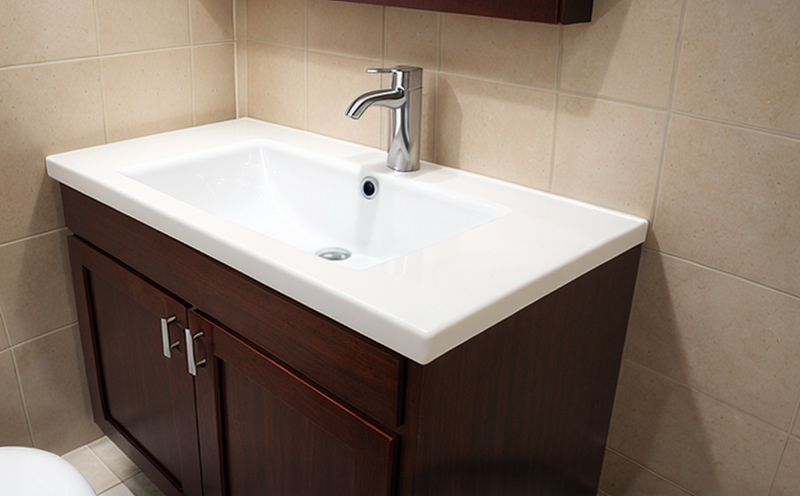ISO 4892 UV Weathering Testing of Bathroom Plastics
The ISO 4892-3 standard specifies the procedure for determining the resistance to the effects of xenon arc light (simulating sunlight), heat, and water on materials used in various applications. This method is widely recognized across the globe as a robust means for evaluating the stability of plastics under UV exposure conditions similar to those found in outdoor environments.
When it comes to bathroom and sanitary plastics testing, this standard plays an instrumental role in ensuring that products maintain their aesthetic appeal, functionality, and safety over extended periods. Bathroom fixtures such as shower curtains, bath mats, and toilet seats are exposed to harsh conditions including humidity, temperature fluctuations, and prolonged UV exposure from natural sunlight or artificial lighting sources. By adhering to ISO 4892-3, manufacturers can demonstrate compliance with international standards while also ensuring longevity and performance of their products.
The testing process involves exposing specimens cut into specific dimensions (typically 150 mm x 150 mm) under controlled conditions using a xenon arc lamp that mimics the sun's UV radiation. Specimens are exposed to both continuous light and water spray cycles designed to simulate real-world environmental stressors. The duration of exposure varies depending on factors like desired test length and expected product life span; however, common durations range from 100 hours up to several hundred hours.
After completion of the UV weathering cycle, specimens are inspected for changes in color, texture, flexibility, hardness, glossiness, or any other relevant properties. If significant degradation is observed after the specified exposure period, it indicates that the material used does not meet acceptable quality standards and may need improvement.
- Environmental Considerations: By ensuring products withstand UV weathering tests according to ISO 4892-3, manufacturers contribute positively towards reducing waste by extending product lifecycles. This translates into less frequent replacements and lower overall environmental impact associated with disposal.
- Sustainability Benefits: Successful passage through this type of testing enhances brand reputation among eco-conscious consumers who value sustainable practices throughout the product lifecycle from manufacturing to end-of-life disposal.
Why It Matters
The importance of ISO 4892-3 UV weathering testing cannot be overstated, especially within the context of bathroom and sanitary plastics. Compliance with this international standard ensures that products maintain their integrity over time under conditions commonly encountered during use. This not only enhances consumer satisfaction but also protects manufacturers from potential liability issues related to product failure.
Moreover, passing these rigorous tests demonstrates a commitment to quality assurance and reliability which can significantly enhance market credibility. For instance, hospitals require materials that are durable enough to withstand repeated cleanings with harsh chemicals without losing their protective properties. Similarly, home bathrooms need fixtures capable of enduring daily use without showing signs of wear or deterioration.
In summary, ISO 4892-3 UV weathering testing serves as a crucial quality control measure ensuring that bathroom and sanitary plastics remain functional, safe, and visually appealing over extended periods. It fosters trust between manufacturers and consumers by providing tangible evidence that products will perform consistently throughout their intended lifecycle.
Environmental and Sustainability Contributions
- Eco-Friendly Design: Materials that pass ISO 4892-3 tests are less likely to degrade prematurely, leading to reduced waste generation. This aligns with broader sustainability goals by promoting longer-lasting products.
- Reduced Resource Consumption: Longer product lifecycles mean fewer replacements, thereby reducing the demand for raw materials and energy-intensive manufacturing processes.
- Better End-of-Life Management: Products that retain their properties after extensive UV exposure are easier to recycle or repurpose at end-of-life, contributing to circular economy practices.
Use Cases and Application Examples
This testing method finds application in various sectors involving bathroom and sanitary plastics. Here are some key examples:
- Bathroom Fixtures: Shower curtains, bath mats, and toilet seats benefit from ISO 4892-3 tests to ensure they remain attractive and functional despite prolonged exposure to sunlight.
- Sanitary Products: Materials used in medical equipment like bedpans or commodes need to withstand harsh cleaning agents without losing their integrity. UV weathering tests help verify these properties.
- Decorative Elements: Tiles and other decorative elements in bathrooms often face significant wear and tear due to daily use. Testing helps ensure durability.





